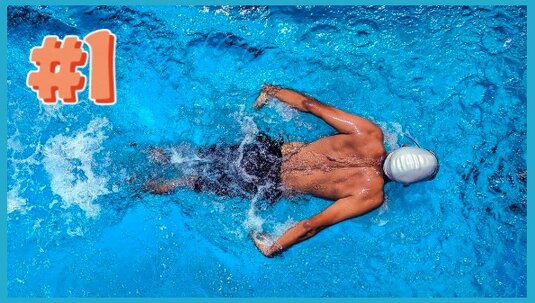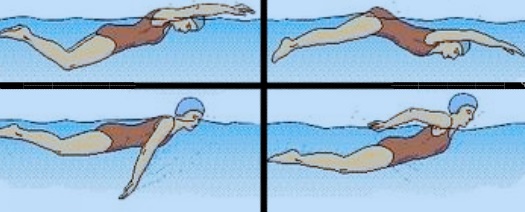You’re in luck if you’ve ever imagined swimming like a butterfly. The very smooth and effective butterfly stroke can help you advance your swimming abilities. Anyone can learn how to perfect it with some dedication. But it takes good technique and lots of practice.
What is butterfly swimming?
Butterfly swimming, also known as the butterfly stroke. This is one of the physically demanding swimming styles. This style requires swimmers to coordinate simultaneous arm movements with a dolphin-like kick while lying face down in the water. This style of swim involves sweeping arms downward and outward in a circular motion while kicking legs in an undulating wave-like pattern. The butterfly stroke is characterized by its distinct elegance when performed correctly; however, it does require some upper body strength, core stability as well as coordination from swimmers who wish to master this technique!

Interesting information about Butterfly swimming:
| # Butterfly swimming, also known as the butterfly stroke. # Butterfly stroke originated from the breaststroke style. # It is considered that butterfly swimming started in 1933. # The butterfly stroke was invented by an Australian named Sydney Cavill. # The inaugural Butterfly competition at the Olympics took place in 1956. # Melbourne Olympics first arranged men’s 200m Butterfly and women’s 100m Butterfly swimming events. # Shelley Isabel Mann was the first women swimmer to win the gold medal in the 100-meter butterfly style in Melbourne Australia Olympics. # In the 200-meter butterfly event at the Melbourne Olympics, William Yorzyk became the first man swimmer to win gold. |
key elements of butterfly stroke:
The key elements of the butterfly style are timing and rhythm. You must coordinate your arms with each kick for maximum efficiency. If one part lags behind or moves too quickly, it will disrupt the flow of movement throughout the body. To get started on perfecting this technique, focus on keeping your arm movements wide yet controlled while also pushing off from each wall strongly as you go along. This will ensure that momentum carries through every length in order to keep up speed without expending too much energy unnecessarily.
Once these basics have been mastered, try adding extra power into each kick by engaging core muscles more intensely than usual – make sure not to overdo it though as exhaustion isn’t conducive towards successful butterfly strokes. Additionally, work on refining hip rotation which should be smooth rather than jerky when transitioning between breaths. Doing so helps maintain balance during turns at either end as well as increase overall speed potentials across all four competitive strokes.
Few tips that can help improve your form:
Start with short distances – When learning any new skill or technique it’s best not to jump into long distances right away. Start small and gradually increase the distance over time so you don’t get overwhelmed too quickly!
Focus on proper breathing – Because butterfly strokes involve alternating arm movements along with leg kicks. Each breath must be taken at just the right moment or else risk losing momentum during turns/flips. Which could lead you off course if done incorrectly (i.e., taking breaths too early). Take time before each practice session to focus solely on breathing patterns until they become second nature when performing other parts of this challenging swim style!
Practice good posture – Keeping your head straight throughout the entire length will ensure maximum efficiency from both arms/legs working together simultaneously without having them work against one another due to a lack of lopsidedness caused by poor posture habits such as chin tucking or shoulder slouching etc…

The history of butterfly swimming: In the World Olympic
The butterfly stroke has a long history in the Olympic Games. In Melbourne in 1956 for women and Helsinki in 1952 for men, the method made its debut. Since then, butterfly swimming has developed into a highly anticipated event that showcases the power, speed, and technical prowess of great swimmers.
Advantages of butterfly swimming:
Full-body workout:
Butterfly swimming engages multiple muscle groups, providing a comprehensive workout for the upper body, core, and legs. It helps build strength, endurance, and power.
Increased cardiovascular fitness:
Due to its demanding nature, butterfly swimming significantly increases heart rate and cardiovascular endurance, leading to improved overall fitness.
Improved flexibility:
The dolphin-like kick and arm movements in butterfly swimming require a good range of motion in the shoulders and hips. Regular practice can enhance flexibility in these areas.
Strong core development:
Butterfly swimming relies on a stable and engaged core for efficient movement. It helps strengthen the abdominal and lower back muscles, contributing to better posture and body control.
Disadvantages:
High energy expenditure: Butterfly swimming is physically demanding and can be exhausting, requiring a considerable amount of energy. This may limit the duration of swim sessions compared to other strokes.
Technical difficulty: The butterfly stroke has a complex and coordinated movement pattern that can be challenging to master. It requires precise timing, coordination, and technique, making it more difficult for beginners or inexperienced swimmers.
Shoulder strain: The powerful arm movements in butterfly swimming place significant stress on the shoulders. Improper technique or overuse can lead to shoulder strain or injury. Especially if swimmers do not have adequate strength or flexibility.
Slower speed for some swimmers: Butterfly swimming can be fast for proficient swimmers. It may not be the fastest stroke for everyone. Individuals with less experience or those who struggle with the technique may find it slower compared to other strokes such as freestyle or backstroke.
Butterfly swimming is a compelling and difficult swimming technique that displays the beauty, strength, and technical prowess of elite swimmers. The butterfly stroke has developed into a distinctive and visually attractive sport, with roots in the modified breaststroke and inspiration from dolphins’ grace. Throughout the world, ambitious swimmers continue to find inspiration in butterfly swimming. It is technically and physically challenging. It is also regarded as the pinnacle of perfection in the world of competitive swimming.
